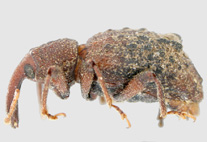Abstract
The genus Niphadomimus Zherikhin, 1987 is taxonomically revised herein. In addition to the two recorded Nepalese species, N. nigriventris Zherikhin and N. niger Zherikhin, known only from the holotypes, two additional specimens of N. nigriventris are reported and six new species from China represented by 96 specimens are described and illustrated. These are: N. alcyone sp. n. (Sichuan), N. celaeno sp. n. (Yunnan), N. electra sp. n. (Yunnan), N. maia sp. n. (Yunnan), N. merope sp. n. (Shaanxi) and N. sterope sp. n. (Sichuan). All known Niphadomimus species are apterous inhabitants of the leaf litter in the upper Rhododendron-dominated forest zone between 2000 and 4114 m. Phylogenetic analyses using DNA barcodes of six new species and representatives of 13 other Molytinae genera with available DNA data (A.) corroborates Niphadomimus monophyly; (B.) strongly argues for the sister-group relationship between N. merope sp. n. from the Qinling Mt. Range and the rest of the species distributed in the Hengduan mountains; (C.) in two among four analyses weakly relates the genus with the East Palaearctic Leiosoma. The tribe Typoderini could not be shown as monophyletic, which may be due to insufficient signal content of the cox1 marker at the tribal level. The detected phylogeographic pattern of Niphadomimus is compared with that of similarly distributed or closely related clades. Temporal DNA analysis estimates the N. merope sp. n. split at 6–11 MY, while the diversification of the Hengduan clade dates between 5.5 MY and 3.6 MY, i.e. well before the onset of the Quaternary climate fluctuations.

